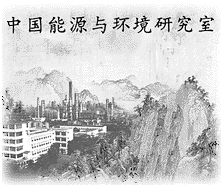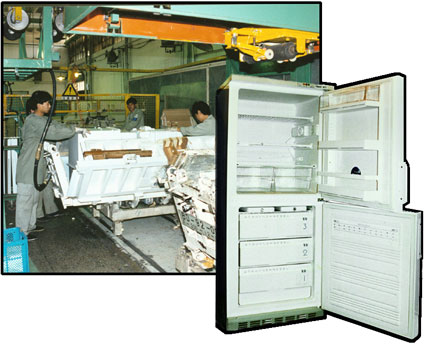|
|
 |
China, the world's most populous nation, has had one of the world's fastest
growing economies since the late 1970s, when its leaders began introducing
market reforms. Much of that growth has been powered by fossil fuels,
especially from the nation's abundant supplies of coal. However, with
the help of technical advice from Berkeley Lab's China Energy Group, as
well as experts from other institutions around the globe, energy efficiency
is playing a larger role in China's energy plans.
|
|
 |
 |
|
|
 |
A symbol of the China Energy Group. |
|
|
Early in its market-reform process, China's leaders took an interest
in promoting energy efficiency. They recognized that economic modernization
could be limited by the availability of energy. Improving energy efficiency
offered the nation a way to keep its developing market economy on track,
as well as a cost-effective option for reducing pollutant emissions from
fossil-fuel-burning plants, a major issue of concern in China today. Because
the country is the world's second largest energy consumer and emitter
of greenhouse gases (GHGs), efforts to reduce these emissions can have
a substantial effect on world GHG levels.
Researchers at Berkeley Lab's Environmental Energy Technologies Division
(EETD) began studying China's energy consumption and began a partnership
to provide technical advice on improving energy efficiency in the late
1980s. From the beginning, the Berkeley Lab collaborated extensively with
the Energy Research Institute, China's most influential energy-policy
think tank. Cooperative work has extended to include other major national
and local centers for energy and environmental research.
This longstanding partnership with the Chinese government has borne considerable
fruit. Among its achievements are the creation of new efficiency programs,
including energy-efficiency standards and energy-efficiency labels. These
were developed with technical assistance by Berkeley Lab researchers,
who have also helped the government to create institutions promoting efficiency,
and to improve its capacity to analyze and understand how China's economy
uses energy.
A partnership with Shanghai
The Lab's work with the city of Shanghai is an example of a recent success.
"Shanghai is the site of a major construction boom," says EETD
director Mark Levine, who also leads the China Energy Group. "However,
many buildings that are going up have been inefficient. City leaders were
concerned and wanted to do something about it." At one point, says
a Chinese news article, there were more cranes per square meter in Shanghai
than anywhere else in the world.
|
 |
|
| In China, demand for appliances is
growing fast. |
|
Berkeley Lab scientist Joe Huang worked with the city to develop a commercial
building energy efficiency standard, which is now in the pilot phase of
implementation. Levine and Jiang Lin, another scientist at the China Energy
Group, have also been helping the Shanghai Municipal Construction Commission
to implement the recently adopted residential building codes for the middle
part of China. According to the Commission's plan, one million square
meters of floor space would be covered by this standard by the end of
2002, and another 3 million square meters of floor space would meet the
standard by the end of 2003.
"We are also supporting Shanghai in the development of market rules
to bring energy service companies into existence," says Levine. Energy
service companies, or ESCOs, are private companies that install energy-efficient
technology in commercial facilities, often earning their fees from a percentage
of the energy savings over a period of years. In this effort, Jiang Lin
is closely working with the Shanghai Economic Commission and the Shanghai
Advisory Committee on ESCOs, led by the deputy Mayor of Shanghai. The
Advisory Committee has authorized more than 30 feasibility studies to
identify savings in commercial enterprises in Shanghai. "One study
identified potential savings of $1 million per year at a pharmaceutical
concern," Levine notes.
Creating appliance energy standards and labeling
One of the largest efforts of the China Energy Group has been to support
agencies developing energy efficiency standards for appliances and energy-efficiency
labeling. Berkeley Lab has provided technical assistance to the U.S. Department
of Energy for years, as DOE promulgates consensus-based efficiency standards
for appliances in the U.S., and it has also provided expertise to the
DOE/Environmental Protection Agency "Energy Star" program to
develop voluntary energy efficiency labeling. So the Lab was an obvious
source of expertise for the Chinese government.
"We have helped the Chinese develop their minimum energy-efficiency
standards program, as well as their energy-efficiency labeling program,"
says China Group scientist David Fridley.
In this effort, China Group researchers work closely with Ms. Li Aixian,
Director of the Standards Group at the China National Institute of Standardization
(CNIS), Li Tienan, Director of the China Certification Center for Energy
Conservation Products (CECP), and others. In recognition of the success
of the minimum efficiency standards program to date, Ms. Li of CNIS was
awarded the EPA's Climate Protection Award in 2003.
In 1980 China produced fewer than 50,000 household refrigerators, 200,000
television sets, 250,000 clothes washers, and 13,000 air conditioners.
By 2001, refrigerator and clothes-washer production exceeded 13 million,
room air-conditioner production soared to 23 million, and more than 40
million color televisions were rolling out of factories, making China
the largest appliance producer in the world. The increase in appliance
ownership has led to an average 16 percent growth in household electricity
consumption per year since 1980. Hoping to stem that tide, in 1989 China's
State Bureau of Technical Supervision (SBTS) issued the first set of minimum
efficiency standards for eight products, including refrigerators, room
air conditioners, clothes washers, and television sets.
|
|
|
 |
 |
|
|
|
|
| New refrigerators, 40 percent more
efficient than today's average, help cope with pollution and increasing
energy demand. |
|
|
|
|
|
SBTS approached Berkeley Lab in 1995 for help as it began to revise its
first energy efficiency standard. SBTS staff came to Berkeley, where researchers
trained them in analytical methods for performing detailed economic and
engineering analyses. These methods were used to produce the revised refrigerator
standard; cooperation on several more standards followed, and the Lab
provided increasing amounts of training.
"Our group has conducted more than 96 person-months of training
for Chinese officials here in Berkeley over the last three years,"
says China Energy Group scientist David Fridley.
One of the first cooperative projects with the Chinese, also started
in 1995, was to help design energy-efficient refrigerators free of ozone-depleting
chlorofluorocarbons (CFCs), with funding from the Global Environmental
Facility (GEF). Fridley, who administered this project for Berkeley Lab,
says, "It resulted in a new design that is 40 percent more efficient
than average existing models. Consumer models based on the design are
being introduced to the market by Chinese manufacturers."
Currently, China has issued minimum efficiency standards for linear and
compact fluorescent lamps, fluorescent lamp ballasts, room air conditioners,
and small and medium motors. A new standard for clothes washers is being
finalized, with involvement by Berkeley Lab staff, the EPA, the Energy
Foundation, and the Collaborative Labeling and Appliance Standards Program
(CLASP), a joint initiative of Berkeley Lab, the Alliance to Save Energy,
and the International Institute for Energy Conservation. For the near
future the successor agency to China's SBTS, the Standardization Administration
of China (SAC), has also planned standards for televisions, central air
conditioners, water heaters, gas appliances, and the revision of the existing
refrigerator and room air-conditioner standards.
Energy efficient China, part 2
|

